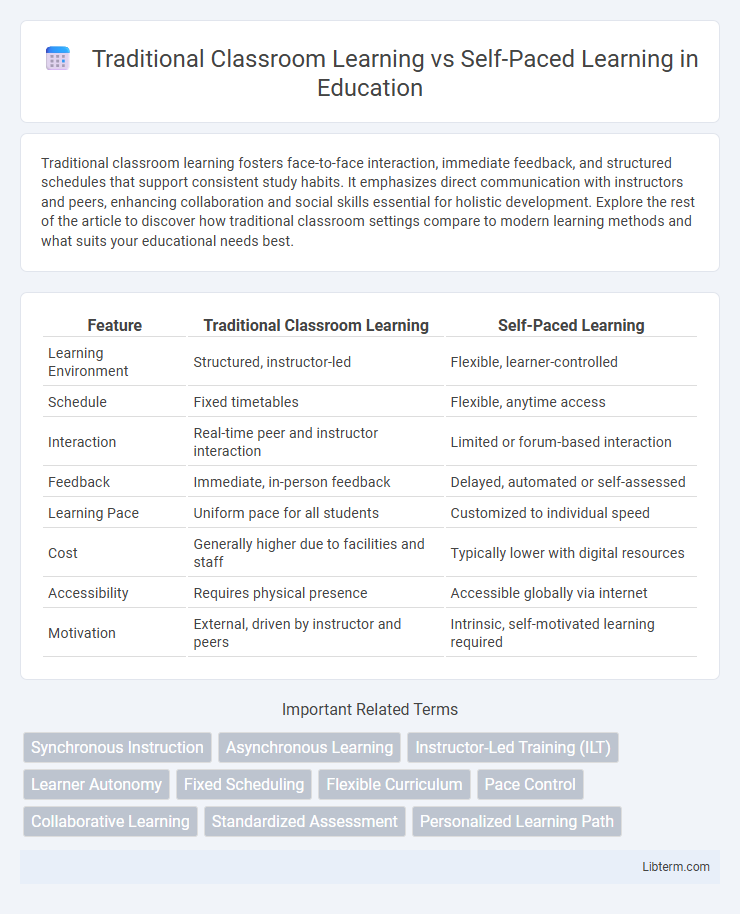Traditional classroom learning fosters face-to-face interaction, immediate feedback, and structured schedules that support consistent study habits. It emphasizes direct communication with instructors and peers, enhancing collaboration and social skills essential for holistic development. Explore the rest of the article to discover how traditional classroom settings compare to modern learning methods and what suits your educational needs best.
Table of Comparison
| Feature | Traditional Classroom Learning | Self-Paced Learning |
|---|---|---|
| Learning Environment | Structured, instructor-led | Flexible, learner-controlled |
| Schedule | Fixed timetables | Flexible, anytime access |
| Interaction | Real-time peer and instructor interaction | Limited or forum-based interaction |
| Feedback | Immediate, in-person feedback | Delayed, automated or self-assessed |
| Learning Pace | Uniform pace for all students | Customized to individual speed |
| Cost | Generally higher due to facilities and staff | Typically lower with digital resources |
| Accessibility | Requires physical presence | Accessible globally via internet |
| Motivation | External, driven by instructor and peers | Intrinsic, self-motivated learning required |
Defining Traditional Classroom Learning
Traditional classroom learning involves structured, instructor-led sessions held at fixed times and locations, fostering direct interaction between teachers and students. This learning model emphasizes real-time participation, immediate feedback, and collaborative activities within a controlled environment. It relies heavily on predefined curricula and standardized assessment methods to ensure consistent educational outcomes.
What is Self-Paced Learning?
Self-paced learning is an educational approach where learners control the speed, time, and path of their study, allowing for flexibility and personalized pacing. This method often utilizes digital platforms, enabling students to access materials anytime and revisit content as needed, enhancing retention and mastery. Unlike traditional classroom learning, self-paced learning caters to individual schedules and learning styles, promoting autonomy and accommodating diverse educational needs.
Key Differences Between the Two Approaches
Traditional classroom learning offers structured schedules with direct interaction between instructors and peers, promoting real-time feedback and collaborative discussions. Self-paced learning allows learners to control the timing and speed of their studies, providing flexibility and customization to individual needs but requiring high self-discipline and motivation. Key differences include the level of learner autonomy, pace control, and the immediacy of feedback, impacting engagement and knowledge retention.
Benefits of Traditional Classroom Learning
Traditional classroom learning offers structured schedules and immediate access to instructors, fostering real-time interaction and collaborative engagement that enhances comprehension. The physical presence of peers and educators creates a motivating environment, promoting accountability and active participation. Hands-on activities and direct feedback in this setting contribute to deeper understanding and skill development.
Advantages of Self-Paced Learning
Self-paced learning offers significant flexibility, allowing students to tailor their study schedules to personal commitments and learning speeds, which enhances retention and reduces stress. It caters to diverse learning styles by providing access to varied multimedia resources and repeated access to materials for thorough understanding. This approach fosters greater autonomy and motivation, empowering learners to take control of their education and progress at their own pace without external pressure.
Challenges Faced in Classroom Environments
Traditional classroom learning often faces challenges such as limited personalization, where fixed schedules and uniform teaching methods hinder addressing individual student needs. Classroom environments can also present distractions and interruptions that impact concentration and overall engagement. Furthermore, the pace of instruction may not accommodate all learners, causing slower students to fall behind and faster learners to feel unchallenged.
Obstacles in Self-Paced Learning
Self-paced learning faces significant obstacles, including a lack of structured guidance and accountability, which often leads to procrastination and incomplete comprehension of complex subjects. Limited interaction with instructors and peers reduces opportunities for immediate feedback and collaborative problem-solving, impacting motivation and engagement. Technical issues and varying digital literacy levels further hinder the effectiveness of self-paced courses, creating barriers that traditional classroom settings typically mitigate through real-time support and social dynamics.
Which Learning Style Suits You Best?
Traditional classroom learning offers structured schedules, face-to-face interaction, and immediate feedback, ideal for learners who thrive on routine and social engagement. Self-paced learning provides flexibility, personalized study pace, and access to diverse digital resources, benefiting those with time constraints or independent learning preferences. Assessing your motivation, time management skills, and preferred learning environment helps determine whether a structured setting or autonomous approach suits you best.
Combining Approaches: Hybrid Learning Models
Hybrid learning models integrate traditional classroom instruction with self-paced online modules, leveraging the strengths of both to enhance student engagement and flexibility. Students benefit from structured face-to-face interactions while accessing digital resources that accommodate individual learning speeds and styles. This combination improves knowledge retention and caters to diverse educational needs, making hybrid models increasingly popular in modern education systems.
Future Trends in Educational Methods
Future trends in educational methods emphasize hybrid models that blend traditional classroom learning with self-paced digital platforms to enhance personalized education. Growth in adaptive learning technologies leverages AI to tailor content to individual students' needs, promoting more efficient skill acquisition outside conventional classroom schedules. Data-driven insights will increasingly guide curriculum development, enabling seamless integration of interactive tools and real-time feedback systems to optimize both in-person and remote learning experiences.
Traditional Classroom Learning Infographic

 libterm.com
libterm.com